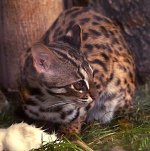 The Leopard Cat (Prionailurus bengalensis) lives in South-east Asia. Its size and fur color differs largely depending on the region. In Indonesia, the leopard cat is as large as a domestic cat, while in the eastern part of China and Russia, it can grow as large as 60 - 90 centimeters long with a 30 - 40 centimeter long tail. It lives in forests near the water.
The Leopard Cat (Prionailurus bengalensis) lives in South-east Asia. Its size and fur color differs largely depending on the region. In Indonesia, the leopard cat is as large as a domestic cat, while in the eastern part of China and Russia, it can grow as large as 60 - 90 centimeters long with a 30 - 40 centimeter long tail. It lives in forests near the water. The leopard cat is a solitary animal and sleeps in caves or hollow trees and is an excellent climber. It hunts at night on birds, rodents, bats, hares or domestic poultry. In the wild, they can become 10 - 15 years of age.
Picture of the leopard cat by F. Spangenberg - Der Irbis, licensed under GFDL
The Leopard cat is listed as Least Concern. Does not qualify for a more at risk category. Widespread and abundant taxa are included in this category, on the IUCN Red List of Threatened Species
Namings for the leopard cat
A young / baby of a leopard cat is called a 'kitten'. The females are called 'queen' and males 'tom '. A leopard cat group is called a 'clowder, clutter, pounce, kindle (young), embarrassment (young),'.Countries
Bhutan, Brunei, Cambodia, China, Hong Kong, India, Indonesia, Japan, Korea, North, Korea, South, Laos, Malaysia, Nepal, Pakistan, Philippines, Russia, Singapore, Taiwan, Thailand and VietnamLeopard cat habitats
Artificial / Terrestrial, Forest, Plantations, Subarctic forest, Subtropical / Tropical Dry forest, Subtropical / Tropical Moist Lowland and Temperate forestSome facts about the
Leopard cat
Adult weight : 5 kg (11 lbs)
Maximum longevity : 17 years
Female maturity :365 days
Gestation : 62 days
Weaning : 45 days
Litter size : 3
Interval between litters : 163 days
Weight at birth : 0.096 kg (0.2112 lbs)
Weight at weaning : 0.62 kg (1.364 lbs)

Custom Search